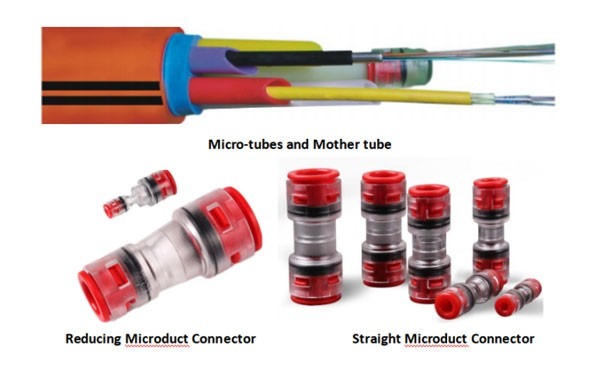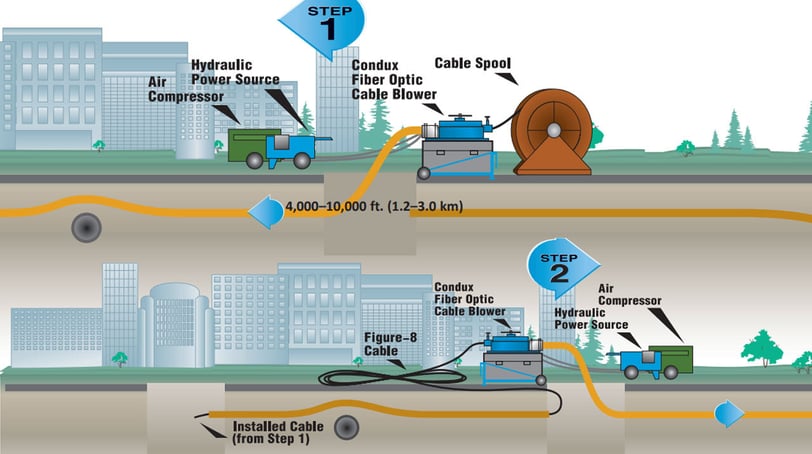
Air blown Microduct is the smart choice for networks
Microducts an innovative approach in the network infrastructures, significantly enhancing the efficiency of telecommunications systems.
10/9/2024


Introduction to Fiber Optic Air Blown Microducts
Fiber optic air blown microducts represent an innovative approach in the management of network infrastructures, significantly enhancing the efficiency of telecommunications systems. These microducts are slender, flexible tubes designed specifically for the installation and maintenance of fiber optic cables. The fundamental operation of air blown microducts is based on the concept of blowing fiber optic cables into pre-installed microduct pathways using specialized equipment. This technique minimizes the need for extensive civil engineering work, thus reducing installation time and costs considerably.
The significance of air blown microduct systems lies in their ability to future-proof network infrastructures. Unlike traditional conduit systems, which often require cumbersome excavation and substantial labor, air blown microducts allow for rapid scalability. Network providers can easily add, remove, or replace fiber optic cables without significant disruption to existing infrastructure. This adaptability to evolving telecommunications needs is essential in today's fast-paced digital environment, where bandwidth requirements continuously grow.
Moreover, the lightweight and compact nature of air blown microducts makes them particularly advantageous in both urban and rural settings. Their design facilitates the efficient use of space while providing a reliable method for deploying high-density fiber installations. As demand for high-speed internet and other data services increases, the necessity for robust and flexible network solutions becomes paramount. This has led to a growing recognition of the importance of deploying air blown microduct systems as a foundational element in contemporary telecommunication strategies.
In summary, fiber optic air blown microducts are a vital advancement in network installation technology, offering significant benefits over traditional methods. Their ability to enhance flexibility and reduce installation time positions them as a crucial component for future network infrastructure development.
Key Benefits of Using Air Blown Microducts
The adoption of fiber optic air blown microducts presents significant advantages for network providers looking to enhance their infrastructure. One of the most prominent benefits is the ease of installation. Unlike traditional duct systems, air blown microducts allow for a swift setup that minimizes labor costs and reduces project timelines. This expedited installation process often leads to a faster return on investment, making it an appealing choice for many service providers.
Another remarkable feature of air blown microducts is their flexibility in network design. Network requirements are constantly evolving, and these microducts enable providers to adapt quickly to changes. The design allows for the easy addition or rerouting of fiber without the need for extensive groundwork. This adaptability supports a variety of applications, whether for residential, commercial, or industrial use, thereby increasing operational efficiency.
Scalability is also a key benefit of air blown microducts. As user demands grow, the ability to upgrade and expand network capacity becomes essential. Fiber optic air blown microducts are engineered to facilitate this growth, allowing for seamless integration of additional fibers as needed. This scalability ensures that providers can meet future demands without incurring significant costs or disrupting existing services.
Moreover, maintenance efficiency is another attribute that enhances the overall value of air blown microducts. The design enables straightforward access to fibers, reducing the time and labor required for repairs or upgrades. This not only lowers maintenance costs but also minimizes service interruptions, thus enhancing overall service delivery. In conclusion, the combination of easy installation, flexibility, scalability, and maintenance efficiency makes fiber optic air blown microducts a strategic choice for network providers aiming to optimize their infrastructure and provide superior services to their customers.
Comparative Analysis: Air Blown Microducts vs. Traditional Fiber Optic Solutions
The landscape of network infrastructure is evolving, with fiber optic air blown microducts emerging as a formidable alternative to traditional fiber optic solutions. When comparing these two technologies, several key factors warrant consideration, including installation time, physical footprint, adaptability, and overall performance.
Firstly, installation time is a critical aspect where fiber optic air blown microducts excel. Unlike conventional methods, which often require extensive trenching and labor-intensive practices, microduct installations are significantly faster. The air-blown technology enables rapid fiber deployment without the need for major underground disruptions, thus reducing downtime and minimizing labor costs. This swift installation process allows network providers to respond promptly to increasing demand for connectivity.
Next, the physical footprint of air blown microducts is notably smaller than that of traditional fiber optic solutions. Microduct systems are designed to be compact, allowing for more efficient use of space. This streamlined design is particularly advantageous in densely populated urban environments where space is at a premium. By utilizing smaller conduits, providers can effectively manage their existing infrastructure without necessitating major renovations or expansions.
Flexibility and adaptability are also vital considerations in today’s evolving technology landscape. Fiber optic air blown microducts facilitate easy upgrades and modifications due to their modular design. This allows service providers to adapt quickly to emerging technologies or shifts in customer demand without the need for extensive reconstruction. In contrast, traditional fiber optic deployment may require significant adjustments that can be time-consuming and costly.
Finally, when evaluating overall performance, microduct solutions provide robust support for high-capacity networks. Their advanced design minimizes signal degradation and enhances reliability, making them an optimal choice for modern communication needs. As network demands continue to rise, the efficiency and performance of air blown microducts position them as the superior solution for a scalable and future-proof infrastructure.
Future Trends in Network Infrastructure and Why You Should Invest Now
The telecommunications landscape is undergoing significant transformation, driven by increased data demands and the burgeoning Internet of Things (IoT). The sheer volume of data generated by IoT devices, ranging from smart home appliances to industrial sensors, is placing unprecedented pressure on existing network infrastructures. Consequently, network providers are compelled to adapt swiftly to these changes to meet consumer expectations and maintain operational efficiency.
Moreover, as urban environments evolve into smarter cities, the requirements for faster and more reliable connectivity will escalate. Smart cities rely heavily on interconnected devices that facilitate real-time data sharing and analysis, directly impacting services such as traffic management, energy distribution, and public safety. To successfully manage this data influx and support the burgeoning smart infrastructure, telecommunication companies must invest in robust and scalable solutions. Fiber optic air blown microducts represent a forward-thinking choice, facilitating easier upgrades and maintenance while enhancing bandwidth capabilities.
The shift towards 5G technology further reinforces the necessity for advanced network infrastructures. High-speed 5G networks are pivotal for supporting the increased data rates demanded by both consumers and businesses. Implementing fiber optic air blown microducts not only streamlines the deployment process but also prepares providers for rapid scalability as demand fluctuates. This technology's flexibility allows for the accommodating of future enhancements without extensive disruption to existing systems, proving advantageous in a fast-paced industry.
In essence, the current trends signify a critical juncture for network providers. Investing in fiber optic air blown microducts now will ensure that they remain competitive and capable of meeting the future challenges of network infrastructure. As telecommunication demands continue to grow, proactive investments in innovative technologies are essential for sustained success and relevance in an ever-evolving market.


Your trusted online source for fiber optic products.
© 2025, All rights reserved to Fiber Xpress Mart.
Contact Us


